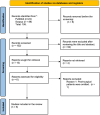Intradermal Incobotulinum Toxin A for Postbreast Cancer Treatment Asymmetry: A Literature Review and Case Report
- PMID: 39754375
- PMCID: PMC11699508
- DOI: 10.1111/jocd.16754
Intradermal Incobotulinum Toxin A for Postbreast Cancer Treatment Asymmetry: A Literature Review and Case Report
Abstract
Background: Botulinum toxin (BTX) is globally the most common aesthetic procedure. Its usage has expanded beyond facial treatments to therapeutic areas, including managing scars and postsurgical deformities. Breast cancer survivors often face significant deformities and asymmetry during recovery.
Objectives: This study systematically reviewed literature from the past 4 years on botulinum toxin applications in breast cancer survivors and presented a case report of a patient treated with Incobotulinum toxin (IncoBonTA; Xeomin, Merz Pharmaceuticals GmbH, Frankfurt, Germany) for left breast deformity postchemotherapy and radiotherapy.
Methods: Following PRISMA guidelines, a systematic search was conducted on PubMed and Scopus using keywords: "botulinum toxin," "breast cancer," and "breast asymmetry," identifying relevant literature from 2020 to 2024. Five full-text articles were included. Additionally, a 2024 case report of a patient with significant breast asymmetry postsurgery and radiotherapy was published.
Results: The literature review indicated botulinum toxin's primary uses in breast cancer include pain management, upper limb impairment, postsurgical scars, and capsular contracture. Although some benefits were reported, further research is needed. In the case report, the patient was treated in one session with IncoBonTA at two different dilutions based on contracture severity without complications.
Conclusion: The review showed promising advances in using botulinum toxin for deformities secondary to oncological treatment in breast cancer patients. The therapy was administered to a 53-year-old patient, resulting in significant aesthetic improvement, especially at the nipple and areola, suggesting that it was a viable option for these patients.
Keywords: aesthetics; botulinum toxin; breast asymmetry; breast cancer; breast reconstruction; postbreast cancer treatment.
© 2025 The Author(s). Journal of Cosmetic Dermatology published by Wiley Periodicals LLC.
Conflict of interest statement
The authors declare no conflicts of interest.
Figures




References
-
- Cancer – World Health Organization (WHO) , “Breast Cancer,” (2023), https://www.paho.org/en/topics/breast‐cancer.
-
- Siegel R. L., Giaquinto A. N., and Jemal A., “Cancer Statistics, 2024,” CA: A Cancer Journal for Clinicians 74, no. 1 (2024): 12–49. - PubMed
-
- do Espirito Santo P. R. Q., Veiga D. F., Boggio R. F., et al., “Mammoplasty: Steps for Safe Surgery. Evidence From Literature,” Revista Brasileira de Cirurgia Plástica 36 (2022): 366–372.
Publication types
MeSH terms
Substances
LinkOut - more resources
Full Text Sources
Medical
Miscellaneous

